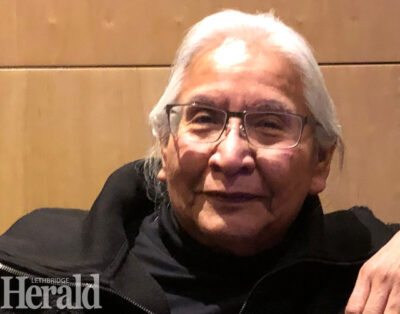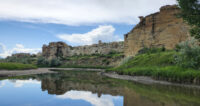Aboriginal artist discusses visual sovereignty
By Chris Hibbard - Lethbridge Herald Local Journalism Initiative Reporter on December 12, 2023.
 Herald photo by Chris Hibbard
Hulleah Tsinhnahjinnie, a photographer and archivist from the greater San Francisco Bay area, spoke recently at the Galt Museum as part of a series of lectures organized by the U of L based group "Indigenous, Radically!"
Herald photo by Chris Hibbard
Hulleah Tsinhnahjinnie, a photographer and archivist from the greater San Francisco Bay area, spoke recently at the Galt Museum as part of a series of lectures organized by the U of L based group "Indigenous, Radically!"A small crowd of University students and communities members descended on the Galt Museum recently to take in a lecture by a prolific aboriginal artist.
Hulleah Tsinhnahjinnie is a talented photographer and archivist who lives in the greater San Francisco Bay area and has taught at the University of California-Davis for more than 20 years.
Her visit to Lethbridge was the result of an invitation from a small local collective known as “Indigenous, Radically!” This was the second of four related lectures that the U of L based group have organized for this year. Their goal is to present aboriginal female artists, more specifically ones who are proud, political and engaged in activism.
Long before Tsinhnahjinnie was an educator however, she was a long-time freelance photographer.
Her main desire in that profession was to capture images of “strong, beautiful, native people – something that I found to be sorely lacking.”
In her youth, with her first Nikon camera, she began taking photographs of family members, landscapes and other things that caught her eye. Once she relocated to San Francisco in 1975, she found a community of like-minded aboriginal individuals, and her subject matter began to change.
She was learning about California’s history, California’s many native American tribes, and how events like the Gold Rush devastated those tribes’ cultures, families and livelihoods on the West Coast.
She began taking photographs of community-level activism, protest marches and events related to land repatriation.
“I wanted to dismantle the ongoing legacies of settler colonialism,” she said. “I learned that photographs could carry what I was thinking and feeling much farther than just myself. I could express family histories, community histories, and reflect on the current and past Federal laws that deeply impacted Native people.”
Over the decades, this role in activism has included protests over statues and their removal, climate change events, the MMIW movement, and annual events such as the Indigenous People’s Day Sunrise Ceremony that takes place on Alcatraz Island.
She mentioned other friends of hers who are working to bring back California Salmon, who’s spawning grounds were destroyed when rivers were dammed. She said another friend is working to have some of those dam removed.
A slide-show that was presented to those in attendance included a long segment about one San Francisco protest that was successful – the removal of a sculpture that had been standing outside City Hall since 1806. The statue depicted a gold miner and a Spanish missionary standing over the body of a native man, both of them looking down on a Plains Indian with racist, berating expressions on their faces. Thanks to protest movements in the San Francisco area, the statue was eventually removed.
“For a long time,” Tsinhnahjinnie said, “children that would pass by the statue every day would feel the racism.” She said that once the Confederate statues started to be torn down across the country, “the momentum was there, and I guess the time was right.”
Tsinhnahjinnie also collects and archives historical (and current) photos of Native Americans, “as they should be seen.”
Many antiquated photos of aboriginals show the aboriginals wearing “white man’s clothes.” So Tsinhnahjinnie started to collect photos of aboriginals wearing traditional dress and bead-work – which she claimed were much harder to find.
“Even the historical development of photography is racist,” she said, explaining how the focus of the range, the exposures and the chemicals used in the earliest cameras were all invented to focus on white skin.
“In those old photos, the images of Indians have been ‘whitenized.'”
Other weighty topics that were discussed briefly in the lecture included repatriation of native lands, the historical displacement and the near-genocide of an entire people.
“Thanks to social media nowadays,” Tsinhnahjinnie said, “you just can’t hide the truth about genocide anymore.”
Tsinhnahjinnie currently makes her students say good morning and good afternoon in a local California tribe’s language, and she said though she’s getting older and is “semi-retired,” the San Francisco aboriginal community knows that if they need her, they can contact her and she’ll come out, and the photo archives will just keep on growing.
And she is a strong believer in the term “visual sovereignty”, which she explained simply as part of her vision, which is: “brown hands holding the camera and photographing their own, and brown hands holding the camera and photographing the outsider.”
22-21




